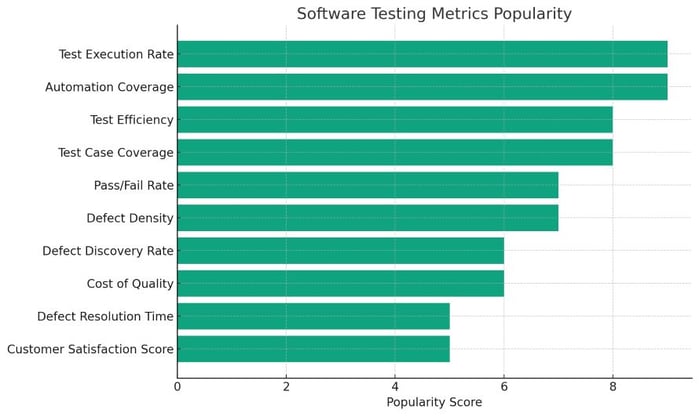Looking to enhance your software testing strategies in 2025? Discover the key metrics to drive efficiency, quality, and success in your software development projects.
Software testing continues to evolve, driven by rapid technological advancements and shifting market demands. In this fast-paced environment, identifying and monitoring the right metrics is crucial for ensuring software quality, enhancing development processes, and delivering value to end-users. This introduction sets the stage for an in-depth exploration of the top metrics for software testing in 2025.
We'll delve into how these metrics can help organizations streamline their testing processes, improve efficiency, and achieve higher software quality, hire software testing engineers to get a superior user experience and competitive advantage in the market.
Businesses prefer to understand the language of numbers. Numbers portray a bigger picture and tell a tale about where your business is going. From operating expenses to business returns, numbers influence critical decisions on cost-cutting, short-term production cycles, and leveraging the latest technologies like AI, automation, etc. They help gauge business performance across diverse projects. Not surprisingly, software testing services are no exception.
In a recent report by GMInsights, the software testing services market stands at USD 45 billion . Companies are in a race to grab the market share as much as possible.
Well, what do you think numbers are in software testing? They are software testing metrics. This blog will discuss software testing metrics, their importance, types, trends, automation, and everything you need to know to take your software testing experience to the next level.
What are Software Testing Metrics?
A recent study by the US's National Institute of Standards and Technology shows that about $60 billion is being lost due to software bugs. These are a result of inadequate testing. Additionally, inadequate testing can potentially harm customer trust and brand reputation. Hence, testing is a critical factor in software development.
Software testing effectiveness is measured through metrics. Missing metrics in software testing makes it difficult to demonstrate software quality. Metrics let you have a quick pulse check on the progress of the testing process, receive feedback, and use it to have better control over software testing.
A planned approach to testing helps identify potential bugs and defects in code before shipping the software. Software testing metrics are exuberant and ease the effort along the way.
Software Testing Metrics - Types
Here's a table summarizing the three fundamental categories of software testing metrics:
|
Metric Category |
Focus |
Purpose |
Examples |
|---|---|---|---|
|
Process Metrics |
Quantifying tests' rate, precision, and soundness |
Enhancing process performance |
Defects identified, defects fixed, time to fix |
|
Product Metrics |
Assessing product’s quality, functionality, performance |
Estimating software size, design, intricacy |
User adoption, churn rate, bounce rate |
|
Project Metrics |
Evaluating overall project well-being |
Detecting risks, bottlenecks, testing progress |
Schedule variance, defect detection productivity, requirement stability index |
This table provides a clear overview of each metric category, their focus, purpose, and examples of metrics used.
Metrics for Testing and Quality Assurance
Software testing metrics ensure structured and bug-free software. They can be further segregated into seven categories based on the parameters they track. Software testing metrics are crucial for evaluating the effectiveness, efficiency, and quality of the software testing process. They provide insights that help in decision-making, process improvement, and resource allocation.

The bar chart ranks the software testing metrics based on popularity score, indicating how commonly they are used in the industry and their perceived value. Metrics like "Test Execution Rate" and "Automation Coverage" score highly, reflecting their critical role in assessing the efficiency and effectiveness of the testing process. On the other hand, "Customer Satisfaction Score" and "Defect Resolution Time" have lower scores, not because they are unimportant, but because they might be utilized less frequently or in more specific contexts compared to other metrics.
This visualization helps in understanding which metrics are most valued by software testing professionals and organizations, guiding teams in prioritizing their testing strategies and improvement efforts.
10 Software Testing Metrics with Detailed Explanations:
-
Test Case Coverage: Measures the percentage of requirements or design specifications covered by test cases. It helps ensure that all aspects of the application are tested, highlighting potential gaps in the test suite.
-
Defect Density: The number of defects found per unit size of the software (commonly per 1000 lines of code). This metric helps in identifying the areas of the software that are most problematic, allowing teams to focus their efforts more effectively.
-
Defect Discovery Rate: Tracks the number of new defects discovered over time. It's useful for understanding the rate at which defects are being identified, which can indicate the quality of the software over different stages of development.
-
Defect Resolution Time: Measures the time taken to resolve defects once they are reported. This metric is crucial for assessing the efficiency of the development and QA teams in addressing and fixing issues.
-
Test Execution Rate: The percentage of tests that have been executed over the total number of tests planned. It helps in tracking the progress of testing activities and identifying any delays or bottlenecks.
-
Pass/Fail Rate: The proportion of tests that pass versus those that fail. This straightforward metric provides a quick snapshot of the current quality of the application and the effectiveness of the testing.
-
Test Efficiency: Calculated as the ratio of the number of defects found during testing to the number of defects found post-release. It indicates the effectiveness of the testing process in catching defects before the software is deployed.
-
Automation Coverage: The percentage of tests that are automated versus those that are manual. High automation coverage can significantly reduce testing time and increase the reliability of testing outcomes.
-
Cost of Quality (CoQ): Represents the total cost of ensuring quality in the product, including the cost of prevention, appraisal, and failure (both internal and external). This metric helps in understanding the financial impact of quality efforts and the value they bring.
-
Customer Satisfaction Score (CSS): Although not a direct testing metric, CSS can indicate the perceived quality and usability of the software by the end-users. It's often derived from surveys and feedback forms post-release.
To illustrate the use and popularity of these metrics, here's a bar chart that ranks these metrics based on their common usage in the industry. The ranking will be based on a combination of factors, including the frequency of use in various organizations, the impact on decision-making, and the overall value to the software testing process.
Importance of Software Testing Metrics
You can assess the value of testing by tracking the correct set of software testing metrics. Metrics reduce effort and increase perceived quality, reliability, and efficiency. Hence, they shorten the Time To Market (TTM) span and help meet the expected business outcomes. In a way, software testing metrics are a gateway to achieving the perceived ROI. Through metrics, testing teams can:
|
|
|
|
|
|
|
|
|
|
In a nutshell, software testing metrics help you understand what was tested.
Software Testing Metrics - Life Cycle
Now that we understand the importance of software testing metrics, the next big challenge would be “How to” analyze them. Software testing metrics life cycle precisely serves the purpose.
To ascertain the success of the software testing process, the software testing metrics life cycle starts with information gathering and progresses towards analyzing, communicating, evaluating, and finally reporting.
We kick start by picking the software testing metrics that help achieve larger business goals. We then collect data from performance tests, logs, bug-tracking systems, and automation tools. Subsequently, the data is used to check the software functionality and recommended changes, if any. Let's look at these stages below:
Analysis
In this phase of the software testing metrics lifecycle, decision-makers and test engineers decide on the quality assurance metrics to monitor and come up with evaluating the framework.
Communication
Once metrics are defined, the quality assurance team communicates the same to the key stakeholders and the testing team. They educate the team about collecting data elements during testing. The data points are later used to process the metrics.
Evaluation
This is a predominant stage of the software testing metrics' life cycle. In this phase, the QA team collects the verified data from the testing teams. The data collected is processed to verify the validity and value of software testing metrics.
Reporting
This is the final stage of the software testing metrics' life cycle. The outcome of this stage is a report with test results and recommendations. The QA team shares the report with the key stakeholders. The stakeholders then evaluate the report and advise on further plans of action.
Choose the Best Software Testing Metrics
As mentioned at the blog's beginning, it starts with choosing the right software testing metrics. Since metrics are tied back to the larger business goals, choosing suitable testing metrics is a quintessential factor in software testing. Ideal software testing metrics should possess the following characteristics:
- Compatible with Business goals: Testing metrics chosen should primarily reflect the purpose and mission of developing the software. With software testing metrics, companies should be able to achieve perceived benefits.
- Contribute to Business growth: Software testing metrics should aid in continually improving the process. There, by challenging industry benchmarks, leaving no room for low performance.
- Provide traceable and understandable data: Ideal software testing metrics should provide coherent data that can be used in making informed decisions.
- Aid in advancing a firm-wide strategy: Metrics should answer key business dilemmas relevant to decisions on acquisition channels, onboarding new features, and competitor strategies. Etc.
Software testing metrics differ from industry to industry. For instance, the cyber security industry focuses more on metrics like mean time to detect, mean time to resolve, mean time to contain, first-party security ratings, security incidents, intrusion attempts, etc.
Likewise, the telecom industry focuses on product-centric metrics such as churn rate, minutes of usage, subscriber acquisition cost, etc.
Conclusion:
In conclusion, the importance of robust testing frameworks and appropriate software testing metrics cannot be overstated in today's digital landscape. As businesses strive to stay ahead of the curve, understanding and leveraging the right metrics becomes paramount.
By meticulously choosing and executing software testing metrics aligned with business objectives, organizations can enhance test planning, mitigate risks, optimize costs, accelerate testing cycles, and heighten the overall quality of their software products.
To delve deeper into the transformative possibility of software testing metrics, consider researching case studies about reducing. And if you are looking for a dependable partner for your software testing requirements, rely on Clarion Technologies. Remember, true success hinges on a comprehensive grasp of pivotal metrics strategically used to propel digital maturation and foster excellence in software testing methods, and this is where Clarion Technologies can be your true growth partner.
Author








